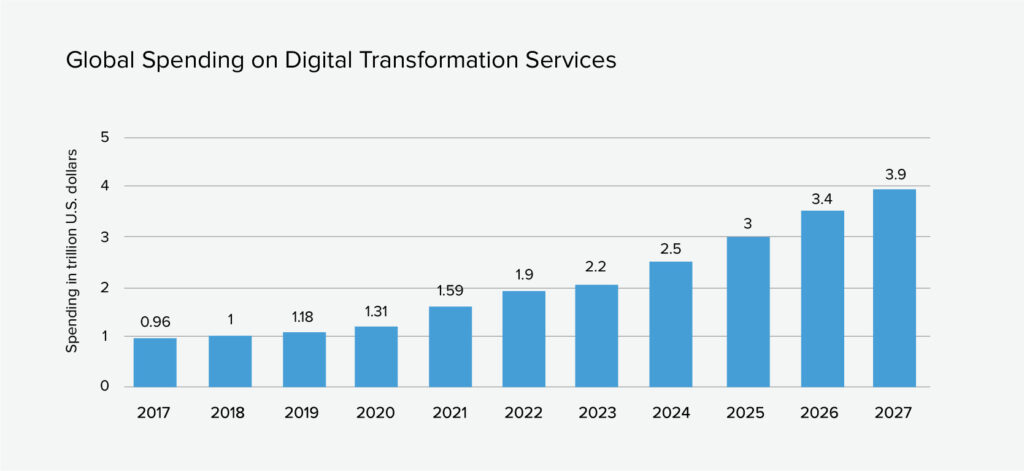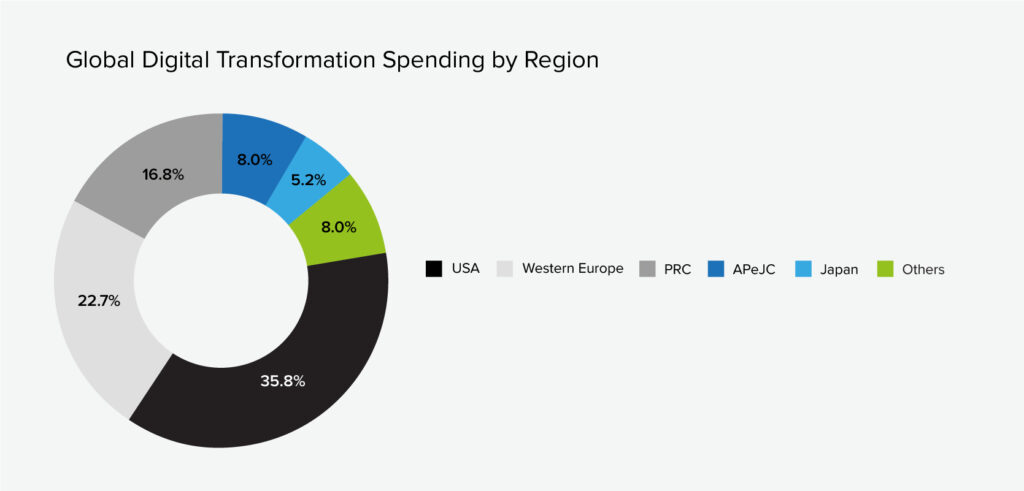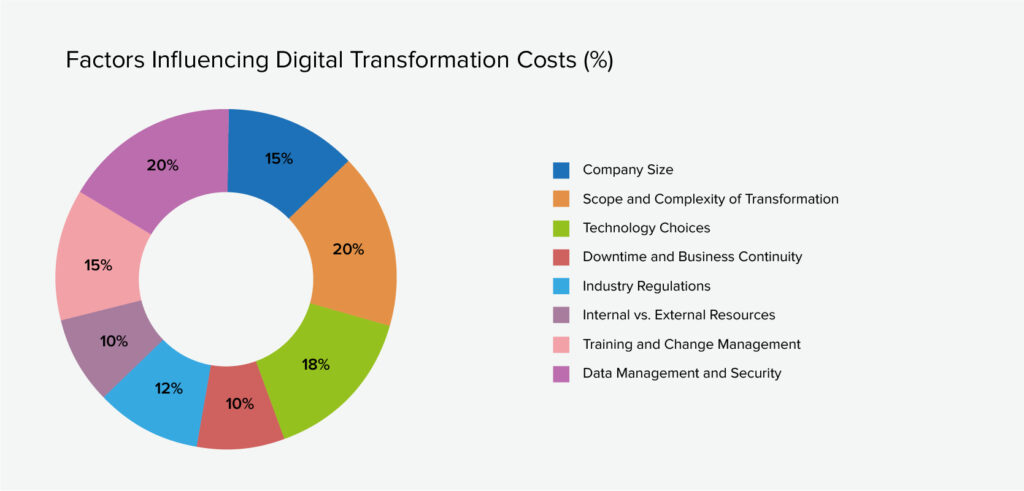Since the COVID-19 pandemic outbreak, digital transformation has been progressing rapidly across all industries. However, some businesses remain hesitant to adopt digital solutions because the costs are often unclear, and numerous stories highlight failed digital transformations due to budgeting problems. In this article, we’ll explain how to estimate the cost of digital transformation and minimize the risk of unforeseen expenses.
Average Cost of Digital Transformation Projects
Getting straight to the key question, “How much does digital transformation cost?” – it’s important to note that this average can be misleading due to significant differences between companies. We’ll explore the main factors influencing total costs later in this article. For now, here are the key takeaways from our research on the average cost of digital transformation for businesses.
General Cost Estimate
The VLM Enterprise Solutions report shows that the average cost of a digital transformation project is $10.9 million. But this is too broad. If we consider this question from the perspective of the organization’s size:
- According to the International Data Corporation (IDC), large enterprises typically invest around $27.5 million in comprehensive digital projects. Besides, some of them allocate up to 5% of their annual revenue to digital transformation initiatives.
- For small to medium-sized businesses, moderate projects usually cost between $50,000 and $500,000.
Breakdown of Spending
To clarify which cost range corresponds to each type of digital transformation efforts, here’s a clear breakdown:
| Transformation Category | Budget Estimate | Details |
| Small-scope digitization | $50,000 – $250,000 | Deploying digital solutions in targeted business areas or enhancing current systems. |
| Mid-level digitization | $250,000 – $1M | Organization-wide rollout of high-tech systems and automated operations. |
| Full-scale enterprise digitization | $1M – $5M+ | Comprehensive restructuring across various departments, innovative business frameworks, and AI integration. |
And here’s what the concise formula for the total cost looks like:
Digital Transformation Cost = Direct Expenses + Indirect Expenses – Expected ROI
Where:
- Direct Expenses include costs for tech purchases, professional services, software licenses, and hardware upgrades.
- Indirect Expenses cover employee training, change management, extra security measures, and unexpected disruptions.
- Expected ROI indicates the projected financial gains, such as improved efficiency, increased revenue, and cost reductions due to digitization.
Global Spending Trends
The ongoing shift towards business digitization in most industries will result in increased spending:
- The total cost of digital transformation (DX) is expected to reach $4 trillion by 2027.

Source: Inoxoft
- By the end of 2025, global IT spending, a key component of business digital transformation, will increase by approximately 9%.
- The projected global spending on generative AI solutions as part of digital transformation efforts will reach $208 billion by 2030.
- The spending on DX in the U.S. alone is expected to exceed $1 trillion by the end of this year.

Source: Inoxoft
- Global healthcare DX spending is expected to hit between $836 billion and $1.3 trillion by 2031.
No matter how large the global expenditure appears, McKinsey research shows that digital and AI skills generate shareholder returns that are two to six times higher than for those less advanced.
Key Factors Influencing the Cost of Digital Transformation
Now, let’s look at where the numbers mentioned earlier come from. The total cost of digital transformation includes many expenses like employee training, technology integration, system upgrades, and more. Some factors are common to all businesses, while different industries may have their own specific DX costs.
Universal Factors Relevant to Any Business
Regardless of the organization type, several factors will greatly influence the costs associated with digital transformation. The percentages reflect estimated contributions based on industry trends outlined by IDC and Gartner.

Company size
Big companies deal with tons of data, serve a diverse range of people, both employees and customers, and require numerous apps to keep their operations running smoothly. The cost of digital transformation isn’t small for these large businesses; it’s way more than for mid-sized companies or startups. Larger, more complex companies usually spend more on going digital, though size isn't always directly linked to spending.
Scope and Complexity of Transformation
Legacy systems, built before cloud and analytics became mainstream, are tough to integrate. With data spread across outdated platforms, digital transformation costs can quickly add up. Cloud-based solutions, designed to manage big data and AI, offer powerful insights and a competitive advantage. The switch can drive profits, but it comes with significant upfront expenses due to data volume and complexity. Careful planning is key to minimizing downtime and ensuring a seamless transition.
Technology Choices
The choice of tech stack impacts the cost of digital transformation because businesses upgrade their operations, including management, data security, and analytics, with tools like cloud CRMs, AI, digital platforms, and more. When you select complex or customized technology, especially with large data storage needs, it can greatly increase expenses. Consultation, support, and training also add to the total cost. Addressing technical debt through API integration or re-platforming may raise initial costs, but it pays off by making operations more efficient and protecting the business.
Downtime and Business Continuity
Faulty tech integrations, flawed data, or improper platform usage can cause errors that disrupt operations and increase digital transformation costs. As a result, businesses face expenses to troubleshoot, rebuild tech stacks, and address client issues caused by downtime. Even outside of active transformation efforts, significant downtime can harm operations and damage the brand reputation. Ensuring business continuity during upgrades is essential, but it raises costs for backup systems and planning.
Industry Regulations
This item largely depends on the industry in which your business operates. For instance, healthcare is highly regulated, and these regulations become more complex when managing multiple countries with different laws. A successful digitization process must comply with all relevant technology regulations, such as HIPAA, GDPR, and other industry standards. Ensuring compliance requires not only knowledge but can also increase the cost of DX. Conversely, failing to comply will likely result in much higher penalties and risks.
Internal vs External Resources
Choosing between your own team and outside experts can significantly impact the cost of digital transformation. Internal staff understand your business well, but training them for complex projects like AI or cloud integration can be expensive. An external team of specialists from a trusted partner, such as Svitla Systems, may have higher initial costs but often offers better long-term cost efficiency. With 60% of companies facing skill gaps, outsourcing can save time and reduce ongoing expenses. Finding the right balance between in-house and external resources is key to keeping your project smooth and budget-friendly.
Training and Change Management
Training and change management can make or break your digital transformation budget, as they focus on getting your people up to speed with new tech. Rolling out solid training for tools like AI or cloud systems isn’t cheap, but it could boost global GDP by $6.5 trillion by 2030. Plus, with 54% of companies facing pushback from employees, you’ll need smart change management to keep things on track. Investing early in these efforts helps prevent issues and prepares your transformation for success.
Data Management and Security
Safeguarding and organizing data is costly but essential. In 2024, companies spent $184 billion on cybersecurity [ZM7] to protect data and comply with regulations such as the GDPR. When it comes to managing large or disorganized datasets, especially during system integration, the costs increase even more. Investing early in robust security and efficient data management ensures a smoother and more secure transformation process.
Industry-Specific Cost Examples
The average cost of digital transformation varies across industries because of different key expense items. Here are a few examples:
Retail
The bulk of retail’s $380 billion digital transformation cost in 2025 comes from building e-commerce platforms and implementing AI for personalized customer experiences. It’s a substantial investment to remain competitive, but the rewards include happier customers and more efficient operations.
Manufacturing
Manufacturers invested nearly $500 billion in 2024 on IoT and automation to enhance production and sustainability. These expenses increase with the challenge of connecting complex systems and managing real-time data across global factories.
Healthcare
Medical institutions are investing over $1.3 trillion in digital improvements, mainly in integrating electronic health records and AI-based diagnostics. The increase in the cost of digital transformation is caused by meeting data security regulations like HIPAA and upgrading systems for virtual healthcare.
Financial Services
Finance is spending heavily, with a 20.5% growth rate, mainly on AI to automate claims and enhance digital banking. Costs increase due to the need for top-tier cybersecurity and systems to meet regulations like GDPR.
Telecom
Telecom’s transformation, which has increased by over 20% in areas like the Nordics, involves significant spending on 5G network upgrades and cloud platforms. Adding advanced analytics to improve customer engagement also results in a substantial expense.
Challenges and Risks Impacting the Cost of Digital Transformation
Several concerns surround DX and its associated costs, and these concerns have valid roots. Fortunately, each can be resolved if addressed promptly. To understand potential issues, review the main challenges your business may encounter during digital transformation.
High Failure Rates
Sad as it might sound, digital transformation projects face a daunting 65% failure rate, greatly increasing costs as businesses deal with stalled efforts or complete abandonment. Missteps often cause costly rework, extended timelines, or additional investments to save projects, especially in complex fields such as manufacturing and healthcare, where integration issues frequently occur.
Common Obstacles
Although the failure rate is high, this is mainly due to common obstacles organizations often overlook. We’ve compiled a comprehensive list of challenges that can lead to increased costs for any business during its digital transformation journey.
| Obstacle | Description | Impact on DX Costs |
| Lack of a clear roadmap | Without a defined strategy, projects lose direction, leading to delays and rework. | Increases costs because of longer timelines and extra resources for course correction. |
| Misalignment with customer needs | Not prioritizing customer-focused tech leads to solutions that miss the mark. | Raises expenses due to redesigns or new implementations to fulfill customer expectations. |
| Lack of skilled talent | 54% of organizations face IT skill shortages, hindering project execution. | Drives up costs with hiring, outsourcing, or extensive training to bridge skill gaps. |
| Employee resistance | 70% of organizations face staff resistance, which slows down implementation. | Incurs higher costs for change management initiatives and extra training to secure buy-in. |
| Legacy system dependencies | 53% of firms struggle with outdated systems requiring complex integrations. | Increases expenses due to custom integrations or temporary solutions that are not sustainable. |
How to Mitigate the Risks?
A brief answer to this question is:
- Start with a clear strategy
- Invest in early upskilling
- Align technology choices with business goals
- Maintain open communication with stakeholders
- Use phased rollouts to reduce staff resistance and technical debt from legacy systems
- Partner with reliable experts, like Svitla Systems, to streamline complex integrations
- Conduct regular progress checks and agile adjustments to minimize disruptions further.
Strategies to Maximize the Digital Transformation Cost Savings
Although digital transformation is one of the most expensive projects a company might undertake, there are many ways to improve the deployment of new technology to achieve better cost-efficiency. You can lower the overall cost of digital transformation by making intelligent choices without compromising quality. Various strategies and DX frameworks exist that help streamline the process and make technology deployment more cost-effective, and here are the most efficient ones.
Consider Pilot Programs
Industry experts recommend starting with small pilot programs, which let companies test new technologies like AI or cloud systems before a full rollout and help reduce the risk of unexpected costs. For example, a mid-sized e-commerce company might pilot a new CRM system to assess integration needs and user adoption, avoiding costly rework.
This approach:
- Helps find inefficiencies early
- Ensures alignment with business goals
- Builds stakeholder confidence
- Reduces the failure rate of transformation projects.
Start small and expand based on proven results–this is how your business can manage budgets wisely and achieve sustainable digital growth.
Pro tip: Turbocharging your pilot program becomes much easier with an external professional team, which enables your business to fast-track solutions and reduce costs by up to 20% through their expert knowledge.
Use Scalable Cloud Solutions
Choose cloud platforms like AWS or Azure. This way, your business can scale resources as needed, cutting initial infrastructure costs and preventing overinvestment in hardware. For example, a financial services firm might use cloud-based CRM to handle growing customer data, cutting maintenance costs by 30% compared to on-premises systems.
This approach was adopted by 92% of organizations by 2023, because it lowers the failure rate of transformation projects by:
- Enabling agile scaling to meet demand
- Simplifying system integration
- Enhancing data security.
Negotiate Vendor Contracts
As a rule, skilled negotiation with technology vendors, such as those offering cloud or AI solutions, can reduce licensing fees, secure flexible payment options, and include support services, potentially saving 10-20% on software expenses. For example, a manufacturing company might arrange a phased payment plan with a SaaS provider to match costs with project milestones, helping to avoid budget overruns. This approach:
- Helps reduce financial strain by locking in cost predictability
- Ensures service-level agreements meet business needs
- Minimizes hidden fees.
Invest in Training and Change Management
Solid training and change management programs help your team adapt to new technologies like AI or cloud systems, reducing resistance and costly errors. For example, a healthcare company might train its staff on a new Electronic Health Record system to prevent issues and cut delays.
This approach reduces the project failure rate by:
- Boosting team member skills
- Winning over stakeholders
- Preventing costly rework.
Focus on Data Clean Up and Analytics
Cleaning up messy data and using powerful analytics tools prepares your business for success with technologies like AI or cloud systems, helping you avoid costly mistakes later. For example, a retail store that organizes its customer data for a sleek new analytics dashboard can improve efficiency and significantly reduce integration costs.
This approach reduces the project failure rate by:
- Enhancing data accuracy
- Providing valuable insights
- Ensuring smooth system operation.
Choose the Right Digital Transformation Partner
To control the cost of digital transformation while reaching your goals, choosing a strong partner can be a game-changer. Consider teaming up with a company like Svitla Systems – a market leader at crafting custom tech solutions. They’ll assist you with challenging projects like cloud migrations or AI configurations without exceeding your budget. For example, a retail business partners with an external team of experts to launch a new e-commerce platform – the company could significantly cut costs with their professional assistance.
This approach reduces the project failure rate by:
- Leveraging the outsourced team’s expertise
- Accelerating DX processes
- Maximizing every dollar spent.
Summing Up
Although the cost of digital transformation for your business may seem high, there’s no need to dismiss the idea based on initial calculations. Think long-term, because the benefits you’ll ultimately gain will surpass the financial investment. To increase the chances of this happening:
- Identify the business goals that DX will help you achieve
- Focus on strategic planning
- Consider selecting a reliable external team of experts for a smooth transition.




![[Blog cover] Digital transformation technologies in healthcare](https://svitla.com/wp-content/uploads/2025/02/Blog-cover-Digital-transformation-technologies-in-healthcare-560x310.jpg)
![[Blog cover] Examples of digital transformation in the pharma industry](https://svitla.com/wp-content/uploads/2025/06/Blog-cover-Examples-of-digital-transformation-in-the-pharma-industry-560x310.jpg)